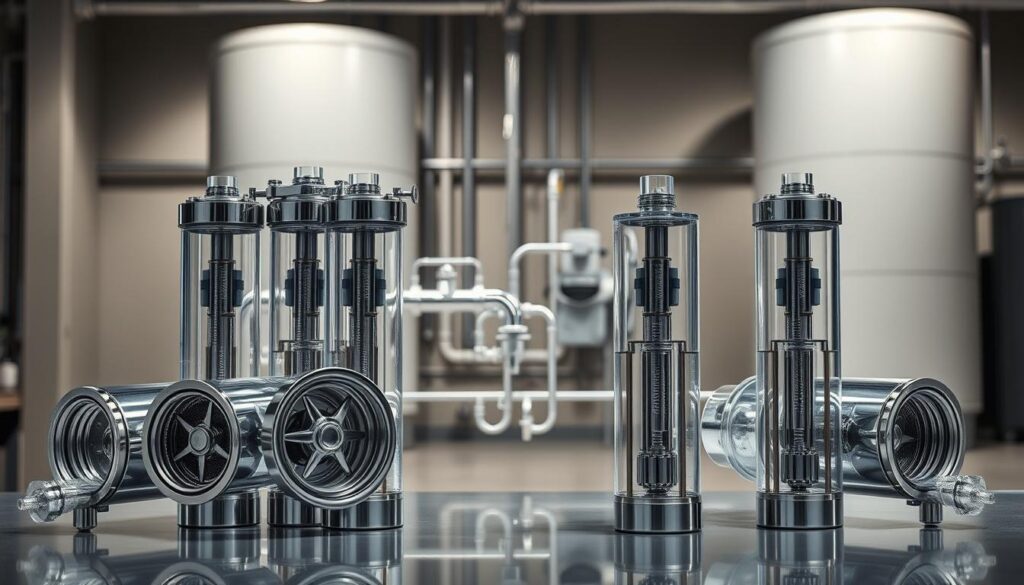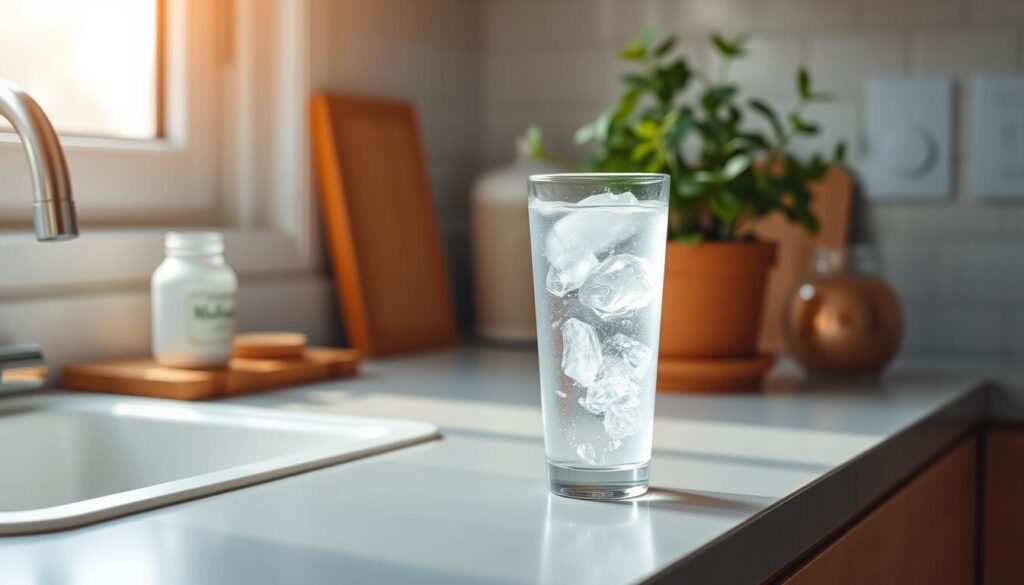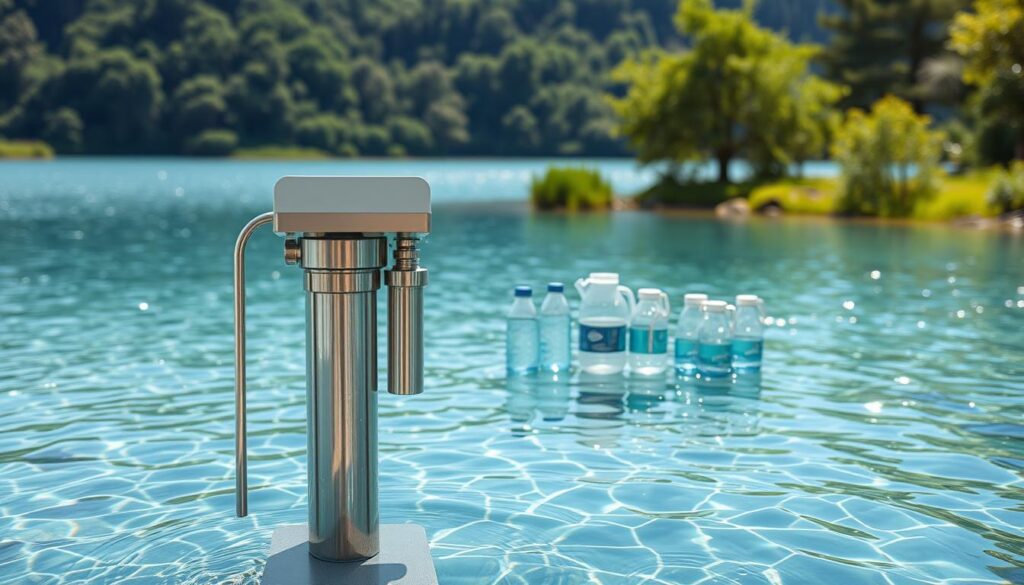Thinking about clean drinking water at home makes me see how key it is. Knowing how to use and keep water filtration systems right is vital.
Ion exchange systems have become more popular for cleaning drinking water.
Learning about this tech and its use in places like industrial settings helps us see its value. It’s important for clean drinking water.
Key Takeaways
- Understand the principle behind ion exchange technology.
- Learn how to effectively use ion exchange water filters.
- Discover the importance of maintaining these filters.
- Explore the application of dual bed deionization systems.
- Recognize the benefits of using ion exchange systems for clean drinking water.
What Are Ion Exchange Water Filters?
Ion exchange water filters are key to better water quality. They remove ions from water, making it purer and tasting better.
Definition and Functionality
Ion exchange water filters use resins to grab and hold ions. These ions are then taken out during a regeneration process. This process involves cation and anion exchange resins that are vital for cleaning water.
The filters work in several important steps:
- Attraction of ions by the resin beads
- Holding of ions until regeneration
- Removal of ions during regeneration
- Replacement of ions with harmless ones
How Ion Exchange Works
The ion exchange process is the heart of these filters. It works by attracting and holding ions on resin beads, which are then removed and replaced. This is key for getting rid of impurities and making water better.
Here’s how it happens:
- The water goes through the resin beads.
- The beads pull in and hold ions like calcium and magnesium.
- During regeneration, these ions are swapped out for sodium or hydrogen ions.
Understanding how ion exchange filters work helps us see the tech behind water purification. It helps us make smart choices about our water treatment needs.
Types of Ion Exchange Filters
The world of ion exchange filters is diverse, with many types to meet different needs. These filters are sorted by the ions they remove or swap.
Cation Exchange Filters
Cation exchange filters remove positively charged ions from water. They are great for reducing water hardness by taking out calcium and magnesium ions. These ions can cause scaling in pipes and appliances.
- Effective in removing heavy metals and other positively charged contaminants.
- Often used in water softening applications.
Anion Exchange Filters
Anion exchange filters target negatively charged ions. They help remove harmful contaminants like nitrates, sulfates, and other anions. These can be bad for health or make water taste bad.
- Capable of removing a wide range of anions, improving water quality.
- Some anion exchange filters can also remove certain types of bacteria and viruses.
Mixed Bed Filters
Mixed bed filters use both cation and anion exchange resins. They offer a complete solution for water purification. These filters are perfect for situations where both positive and negative ions need to be removed.
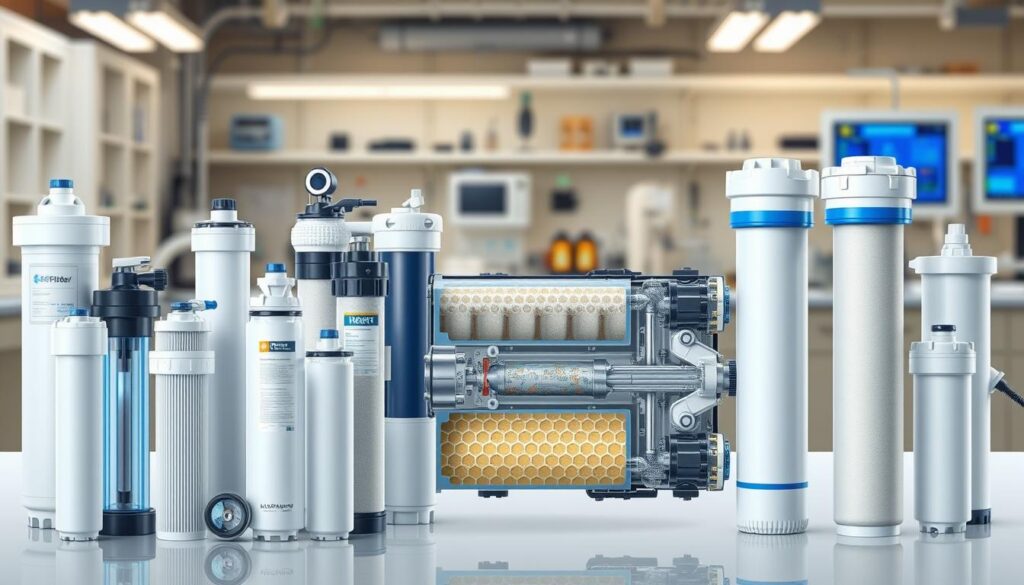
- Provide high-purity water by removing a broad spectrum of contaminants.
- Often used in laboratories, pharmaceutical applications, and other industries requiring ultra-pure water.
Choosing the right ion exchange filter is key. Top brands offer a variety of products. They range from simple water softeners to complex industrial water purification systems.
Benefits of Using Ion Exchange Filters
Ion exchange filters are great for water treatment. They remove impurities, making water safer and more enjoyable to drink.
These filters improve water quality, lower water hardness, and remove contaminants. They are excellent for making water better for various uses.
Improved Water Quality
Ion exchange filters greatly enhance water quality. They remove ions and impurities, improving taste, smell, and overall quality.
- Removal of heavy metals and other inorganic compounds
- Reduction of nitrates and other contaminants
- Improvement in water clarity and appearance
Reduced Hardness
These filters also reduce water hardness. Hard water can harm plumbing and appliances. Ion exchange filters help prevent this.
They remove calcium and magnesium ions, which cause water hardness. This prevents scaling and protects pipes and appliances.
Removal of Contaminants
Ion exchange filters remove many contaminants, including bacteria and viruses. They are very effective.
Some of the key contaminants that can be removed by ion exchange filters include:
- Lead and other heavy metals
- Nitrates and nitrites
- Chlorides and other inorganic compounds
Overall, ion exchange filters are a smart choice for better water quality.
How to Choose the Right Ion Exchange Filter
Choosing the right ion exchange filter is important. You need to know what your water quality needs are. Look at several factors to pick the best model for you.
Factors to Consider
First, think about the contaminants in your water. Ion exchange filters can remove heavy metals and other compounds. For hard water, a cation exchange filter might be best. For nitrates or other anions, an anion exchange filter is better.
Next, consider the filter’s flow rate. It should match your household’s water demand. Also, think about how often it needs to be regenerated and the regeneration process. These affect its efficiency and upkeep.
Comparing ion exchange filters with other technologies, like reverse osmosis filters, is also smart. Reverse osmosis filters remove many contaminants. But, ion exchange filters have special benefits, like removing certain ions and improving water quality.
Brand Recommendations
Choosing a brand is key. Look for brands known for quality ion exchange filters. Check their customer service, availability of parts, and overall cost.
By considering these points and doing your homework, you can find an ion exchange filter. It should meet your water quality needs and offer long-term value and reliability.
Installation Process for Ion Exchange Filters
To get the most out of your ion exchange filter, proper installation is key. I’m here to guide you through it. Installing an affordable ion exchange water filter might seem hard, but with the right tools and steps, it’s easy.
Tools and Materials Needed
Before you start, gather all needed tools and materials. You’ll need the ion exchange filter unit, piping, fittings, valves, and a drain line. Make sure everything fits your water filtration needs.
Having the right tools makes installation smoother. You’ll need a pipe cutter, Teflon tape, and a wrench. Also, have a bucket and rags ready for spills.
Step-by-Step Installation Guide
The installation has several key steps. First, shut off the main water supply to avoid water flow. Then, cut the pipes to the right length with a pipe cutter for a clean fit.
Next, put the filter system together by connecting the pipes and fittings as the manufacturer says. Use Teflon tape on threaded connections to avoid leaks. After that, connect the filter to the water supply lines, making sure they’re tight.
- Mount the filter unit in a good spot, making it easy to get to for maintenance.
- Slowly open the main water supply valve and check for leaks around the connections.
- Lastly, flush the system to get rid of air or debris that might have gotten in during installation.
By following these steps and using affordable ion exchange water filters, you can have clean, purified water at home. Regular checks and maintenance will keep your filter working well for a long time.
Maintenance and Care Tips
To keep your ion exchange water filter working well, regular maintenance is key. It’s not just a suggestion, it’s a must. Proper care helps the filter keep removing bad stuff from your water.
Regular Checks and Replacements
It’s important to check the filter often for any problems. Look for signs like less water flow or changes in taste and smell. Replacing parts or the whole filter when needed is vital for clean water.
Check the maker’s guide for when to replace parts. Ion exchange resins usually need to be swapped out every 6 to 12 months. This depends on how much you use it and your water’s condition.
Best Practices for Longevity
Using the right practices can make your filter last longer. Here are some tips:
- Regularly clean the filter housing and pipes
- Keep an eye on water pressure to avoid too much stress on the filter
- Stay away from very hot or cold temperatures
- Use the right salt for regeneration, if needed
By following these tips, your ion exchange filter will work better for a longer time.
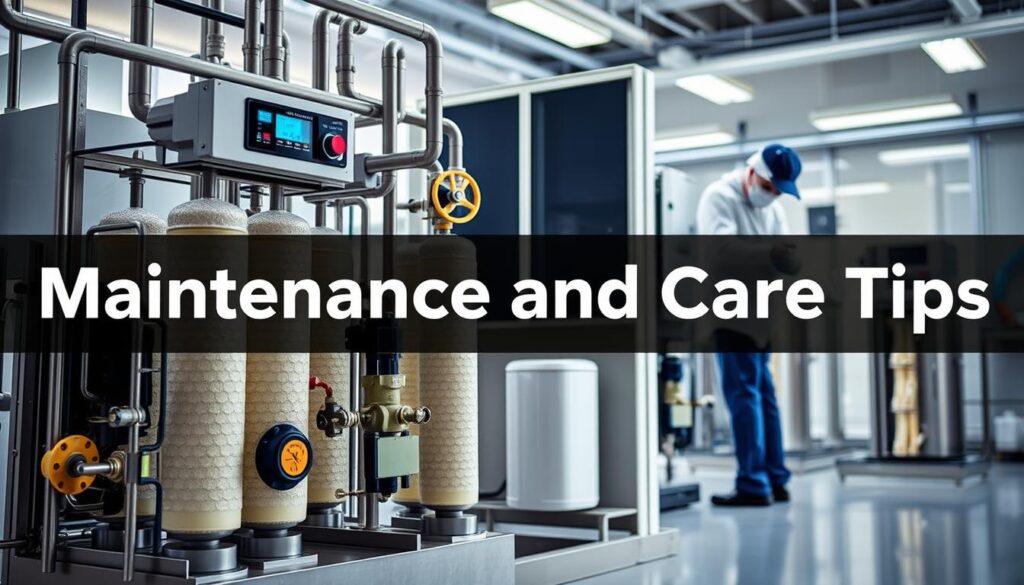
| Task | Frequency | Importance |
|---|---|---|
| Inspect filter for wear and tear | Monthly | High |
| Replace ion exchange resins | Every 6-12 months | High |
| Clean filter housing | Quarterly | Medium |
| Monitor water pressure | Monthly | Medium |
Common Issues and Troubleshooting
Ion exchange filters can face several problems that affect their performance. Knowing how to fix these issues is key. I’ve seen how solving these problems can make the filters work better.
Identifying Problems
Ion exchange filters can run into issues like fouling and resin degradation. Fouling happens when contaminants block the resin, making it less effective. Resin degradation occurs when the resin breaks down, impacting its ion exchange ability.
Other problems include channeling, where water doesn’t flow evenly, and resin loss during regeneration or backwashing. Spotting these issues is the first step to fixing them.
Solutions and Fixes
After finding the problem, the right fix is essential. For fouling, regular cleaning and maintenance can stop contaminants from building up. If the resin degrades, you might need to replace it.
To fix channeling, adjust the flow rate or redistribute the resin for even water flow. To prevent resin loss, fine-tune the regeneration and backwashing steps.
- Regularly check the filter for fouling or resin degradation signs.
- Adjust maintenance schedules as needed to prevent issues.
- Consider upgrading to more durable resin or improving the pre-treatment process to reduce contaminant load.
By understanding these common problems and applying the right fixes, you can make your ion exchange water filter last longer and work better.
Ion Exchange Resins: An Overview
Understanding ion exchange resins is key to making ion exchange filters work better. These resins are at the heart of the filters. They help remove impurities from water through a complex process.
The resins in ion exchange filters are made from synthetic materials. They attract and retain specific ions. The quality of these resins directly impacts the filter’s efficiency and effectiveness. There are different types of resins, each with its unique characteristics and applications.
Types of Resins Used
Ion exchange resins are broadly categorized into two main types: cation exchange resins and anion exchange resins. Cation exchange resins remove positively charged ions. Anion exchange resins target negatively charged ions.
- Cation exchange resins are often used to remove calcium and magnesium ions, which cause water hardness.
- Anion exchange resins are used to remove negatively charged ions such as nitrates and sulfates.
Mixed bed resins, which combine both cation and anion exchange resins, are also available. These are effective in producing high-purity water by removing a wide range of contaminants.
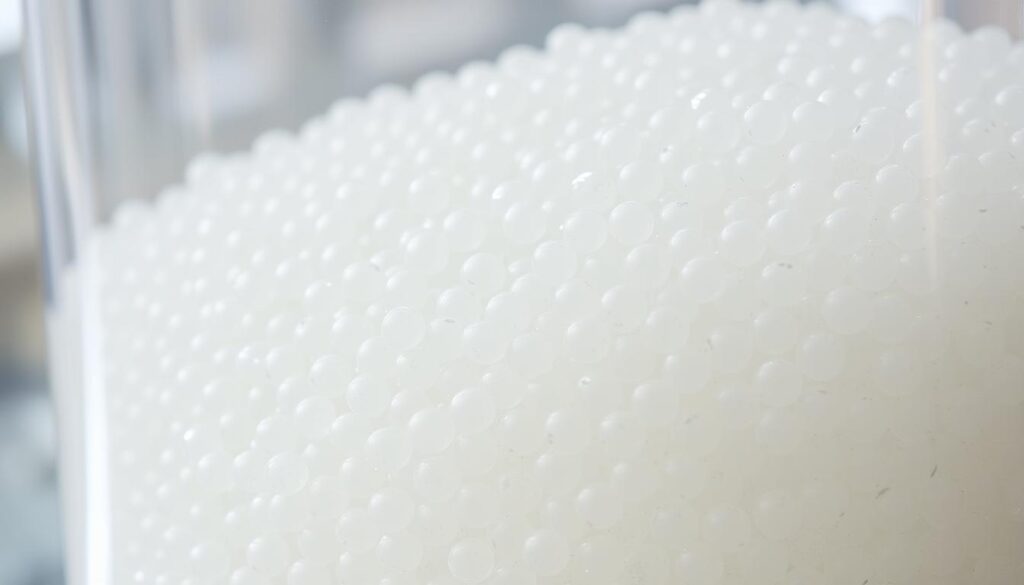
Lifespan and Replacement
The lifespan of ion exchange resins depends on several factors. These include the quality of the resin, the amount of contaminants in the water, and the regeneration frequency. Typically, ion exchange resins can last anywhere from a few months to several years.
| Resin Type | Average Lifespan | Factors Affecting Lifespan |
|---|---|---|
| Cation Exchange Resin | 1-3 years | Water hardness, regeneration frequency |
| Anion Exchange Resin | 2-5 years | Presence of negatively charged ions, maintenance quality |
| Mixed Bed Resin | 1-2 years | Water purity requirements, usage rate |
Regular monitoring and maintenance are key to extending the lifespan of ion exchange resins. I recommend checking the resins periodically and replacing them when necessary. This ensures the ion exchange filters work at their best.
Regeneration of Ion Exchange Filters
Knowing how to regenerate ion exchange filters is important. This process makes the filters work better by refreshing their ion exchange capacity.
Understanding the Regeneration Process
The regeneration process has several steps. It starts with backwashing, then adding a regenerant like salt or acid, and ends with rinsing. For more info, check out this resource on keeping your ion exchange resin in top shape.
Backwashing is the first step. It uses water to flush out dirt and debris from the resin. Next, the regenerant is added to bring back the resin’s ion exchange power.
How Often Should Regeneration Occur?
How often you need to regenerate depends on a few things. These include the filter type, water quality, and how much water it processes. You’ll know it’s time when the water quality drops or the filter’s pressure increases.
Keeping an eye on the filter’s performance is key. Regenerating too often wastes resources and money. Not often enough can make the water bad. So, finding the right time to regenerate is important for keeping the filter working well.
Regular maintenance, including regeneration, is vital for ensuring the longevity and efficiency of ion exchange filters. By following the right steps for regeneration, you can keep your water quality high and make your filters last longer.
Cost Analysis of Ion Exchange Water Filters
It’s important to know the costs of ion exchange water filters before deciding. These filters might seem expensive at first. But, they can save you money in the long run.
Initial Purchase vs. Long-Term Savings
The first cost of ion exchange water filters is higher than some other systems. But, think about the long-term savings. They last longer and need less maintenance, saving you money over time.
These filters are a smart choice for homes and businesses. They remove contaminants well and last a long time. For example, they stop scale buildup in appliances, saving energy and extending their life.
Breakdown of Operating Costs
Operating costs include regeneration, maintenance, and replacing resins. Regeneration costs depend on how often and how you do it. Some systems use salt or chemicals, adding to the cost.
Maintenance expenses are lower for ion exchange filters. They need less part replacement. But, remember to include the cost of replacing resins, as they wear out over time.
Here’s a simple breakdown of typical costs:
- Regeneration costs: $50-$100 per year
- Maintenance expenses: $20-$50 per year
- Replacement resins: $100-$300 every 5-10 years
Knowing these costs helps you decide if ion exchange water filters are right for you. In my experience, the long-term savings and benefits make them a good choice.
Conclusion: The Future of Water Filtration
Ion exchange technology is getting better, making water filtration systems more effective. As we move forward, new innovations will keep improving these systems.
Advancements in Ion Exchange Technology
New developments in ion exchange resins and regeneration processes are making systems more efficient and eco-friendly. For example, better resin technology means these systems can handle more and last longer.
My Recommendation for Ion Exchange Filters
I suggest using ion exchange filters for clean drinking water. They are great at removing harmful substances and softening water. With ongoing tech advancements, we’ll see even better water filtration options.
FAQ
What is the basic principle behind ion exchange water filters?
Ion exchange water filters remove ions from water. They use cation and anion exchange resins. These resins attract and hold ions, which are then removed during regeneration.
What are the different types of ion exchange filters available?
There are cation exchange filters for positively charged ions, anion exchange filters for negatively charged ions. Mixed bed filters combine both, allowing users to choose based on their needs.
How do I choose the right ion exchange filter for my needs?
To choose the right filter, consider your water quality needs. Compare different brands and understand how they compare to other technologies like reverse osmosis.
What are the benefits of using ion exchange filters?
Ion exchange filters improve water quality and reduce water hardness. They remove various contaminants, making water better for different uses.
How often should I regenerate my ion exchange filter?
Regeneration frequency depends on usage and resin type. It’s important to understand this for the filter’s effectiveness.
What are the operating costs associated with ion exchange water filters?
Operating costs include initial purchase and long-term savings. Understand the breakdown of costs, including maintenance and resin replacement.
How do I maintain my ion exchange filter to ensure its longevity?
Regular checks and replacements are key. Following maintenance best practices can extend filter life and ensure effectiveness.
Can I install an ion exchange filter myself?
Yes, you can install it yourself with the right tools and materials. A step-by-step guide can help, making it accessible for various budgets.
How do ion exchange filters compare to reverse osmosis filters?
Both are effective, but they work differently. Understanding their differences is important for choosing the best option for your needs.
What is the lifespan of ion exchange resins, and when should they be replaced?
Knowing the types of resins and their lifespan is key for maintenance. Knowing when to replace them ensures the filters keep working well.

